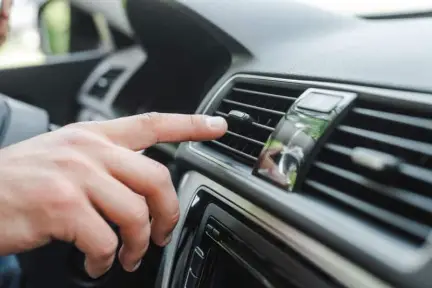
Feeling no or hot air blowing out of the vents when the temperature outside is around 90° F is unbearable. Sometimes, your car AC fan not working properly is also dangerous to health.
Your "Why is my car AC blower not working?" question has several answers, and below we'll explore the main ones:
- A broken condenser fan
- Refrigerant leakage
- A blown A/C unit fuse
- A clogged condenser coil or fan
- Faulty blower motor resistor or broken blower motor
- Damaged wires.
6 causes for your "car cooling fan not working" problem
Your car air conditioner is part of the climate control unit with many components. You won't feel the desired coolness once even its minor element functions incorrectly. Let's check what causes a car AC to stop working.
1. A broken condenser fan

A condenser is a plate with coils located in front of your radiator. Here, the R-134a or R1234yf refrigerant gives away the heat absorbed from the cabin air. This happens due to the fan moving air around the condenser coils.
Eventually, this fan ensures the delivery of cooled air to the car's interior. Also, the condenser fan keeps all the other elements of the AC system working at optimized temperatures.
So once this device doesn't spin or moves slowly, you'll feel lukewarm or hot air coming from the vents. Moreover, your compressor can overheat and break.
You'll need to check if the fan spins by looking at it under the hood. Among the possible failure causes are a blown fan motor, a faulty capacitor, a failed relay, or damaged electrics.
2. Refrigerant leakage

Your AC system works effectively only when its refrigerant is isolated. It moves from the compressor to the condenser, thermal expansion valve, evaporator, and drier/accumulator.
The tubes the refrigerator travels through are looped, so your R-134a or R-1234yf gas never ends unless it leaks out.
This can happen when the rubber seals in joints dry out and tear apart since metal hoses and reservoirs don't degrade or crack. However, they can break after a collision or corrode due to winter road salt.
Once the refrigerant leaks, the cooling effect of the AC system fades, and lukewarm air blows to the cabin. Moreover, the heart of the air conditioner — its compressor — can overheat and stop working. Also, your vehicle will eat more fuel while making the AC work harder.
The common locations of coolant leaks are the service fittings, compressor shaft seal, tube connections, evaporator, and condenser. In case of leakage, you may notice spots under your car or smell a sweet odor from the exhaust pipe.
3. A blown A/C unit fuse

Fuses are metal strips in plastic covers that protect electrical components from extreme amperage. In modern AC units, you'll find several fuses securing the condenser, compressor, ventilation system, and fans.
Once a fuse meets excessive current, it breaks (blows). Then, the current circuit will be dead in the entire section powered through that fuse. So, if one of the air conditioner fuses blows, the AC may or may not stop working.
You may feel a weak flow of cool air or an intense blowing of lukewarm air or hear your car AC fan not turning on.
Replacing a broken fuse isn't a problem; you'll only need to identify the right one, disconnect it, buy a similar detail, and place it back. Check your car's manual to see the fuse box diagram. It'll let you identify what's connected to each safety device.
You'll understand a certain fuse is blown once you notice melted wire around it. Also, if you disconnect it and check the strip against the light, it'll be damaged.
4. A clogged condenser coil or fan

As mentioned above, a condenser takes the heat away from the refrigerant with a fan and moves it to other A/C elements. It includes many parts, like the motor, the coil, rubber seals, the relay switch, and the run capacitor.
Since the condenser sits at the front of your car, any of its parts, including coils and fan blades, can get clogged with debris. This makes refrigerant cooling less effective, and consequently, the AC will deliver warmer air to the cabin.
To clean the condenser grill, you'll need first to check the owner's manual and learn where it's located and how to remove the cover. Then, spray the coil cleaner on the tubes and leave it for a while. After that, wash with a moderate water flow and let it dry completely.
5. Faulty blower motor resistor or broken blower motor

When the air conditioner is on, you'll often change its speed. But the blower motor fan can either blow or not in older cars. That's where the resistor grows or decreases the electricity flow to the blower fan motor.
Once the resistor goes bad, the AC fan can still be working. However, it'll either work at one speed or stop blowing completely. You'll understand the motor itself is falling once the airflow is inconsistent or weak.
You can check if current goes through the resistor with the help of a multimeter. For this, you'll need to take the electrical connector out of the motor and measure its voltage after turning the AC on.
Change the fan speed and check the multimeter readings — they should be around 12 volts. If so, the resistor works properly; the problem might be with your blower motor.
When the voltage at certain fan speeds is missing or too low, you should replace the resistor. We recommend changing both devices simultaneously.
6. Damaged wires

Electrics are an essential part of the AC unit's functioning. But when wires get damaged, they can no longer transfer current from the alternator and battery to the air con elements. That's when you'll have the fan not spinning on the AC unit.
The power supply weakens or stops because wires shift, expose, or break. So your temperature, toggle, and trinity switches, as well as the compressor, relay kit, and condenser fan can be de-energized.
On the other hand, excessive current provokes electrical shorts that make wires burn and details nearby melt. That's why one of the signs of this problem is the smell of burning rubber or melting plastic or a fishy odor going from the vents.
You'll need to visit a mechanic, whether your vehicle requires only replacing a wire section or fixing a major problem with electrics.
Wrapping up
Why is your car air conditioner fan not working? It might be a blown fuse, a non-working condenser, refrigerant leakage, and several more reasons. We've mentioned six main problems that cause your air con to work incorrectly.
Some of them you can solve without professional help, but other issues like leaking coolant or damaged electrics will require going to a workshop.
Same articles

Anonymous Cryptocurrency Exchange: Unlocking Confidential, Flexible Crypto Trading in 2025
GuidesThe concept of an "anonymous cryptocurrency exchange" has become a focal point in the digital asset world as privacy, user autonomy, and security have...

Renting a Car: What Do You Need to Know
GuidesEmbarking on the journey of renting a car for the first time can be akin to navigating uncharted waters. It's a path many have traversed, driven by the need for convenience, exploration, or...

Fuel Additives For Petrol And Diesel Engines - What Are Pros And Cons?
GuidesIn theory, the use of fuel additives is not necessary for most engines. However, this only applies if the engine operates under ideal conditions, meaning it always has access to clean...

